This is part two of an article series detailing Dr. Fauci’s funding of Dual-Use Research of Concern (DURC) and Gain-of-function research through the NIH and NIAID. Part I can be found here.
IN THIS ARTICLE:
- Dr. Ralph Baric was awarded approximately $30 million in NIH grants between 2004-2019 to perform GoF research on SARS viruses.
- In 2014-15 Baric and Dr. Shi Zhengli at Wuhan Institute of Virology engineered a brand new SARS coronavirus.
- The virus engineered through the US/China partnership was previously unable to infect humans and specifically targeted human airway cells.
- Baric’s research should have been paused due to a US government moratorium but Fauci allowed it – and the funding – to continue.
In the early part of 2003, doctors around the world became baffled by thousands of cases of people with flu-like symptoms and pneumonia. Originally beginning in the Hong Kong region and then spreading around the world, this mystery illness was killing people faster than they could be diagnosed. When American businessman Johnny Chen became ill on a flight to Singapore, the plane diverted to Hanoi in Vietnam to rush Chen to the hospital. There, doctors were unable to stop the progression of Chen’s symptoms, and within hours of his arrival, Chen was dead. Over the course of the next several days, nearly 40 people would become ill at that hospital with 7 of those people dying from this new mysterious disease. That disease went on to infect people all over the world. China was among the worst hit, with over 5,000 cases and 318 deaths, followed by Canada and the US, with over 300 cases and 30 deaths.
It wasn’t until the SARS virus genome was identified by Canadian scientists in April 2003 that the world began to understand the cause of all the sickness and death that was spreading across the globe. Then in May 2003, researchers out of Erasmus University in the Netherlands were able to determine that this new virus, the definitive culprit in the sickness that had spread to nearly every continent. The doctor that led that research? Dr. Ron Fouchier. (Remember that name.)
In the years that followed this new outbreak, virologists and epidemiologists around the world raised concerns about the return of SARS or worse yet, the rise of a more severe form of SARS through another zoonotic spillover event, like the one that led to the outbreak of SARS-CoV. A relatively new type of research called “gain-of-function” was promoted as the means to defeat SARS and prevent the next outbreak. That form of research was already being used to experiment with various influenza strains, so it only made sense to apply the research to other viral strains as a means of developing treatments for potential mutations. As covered yesterday, this type of research requires the use of genetic science to mutate viruses to make them more deadly and transmissible. Despite the list of threats that comes with performing those types of experiments, scientists pressed forward in their studies.
At the forefront of US research into the SARS virus was Dr. Ralph Baric of the University of North Carolina. Beginning as early as 2004, Dr. Baric was given grants from the National Institutes of Health and Dr. Anthony Fauci’s National Institute of Allergy and Infectious Diseases to perform genomic research on the SARS virus in the hopes of giving us a bit of insight into a means of understanding the initial outbreak of the deadly disease.
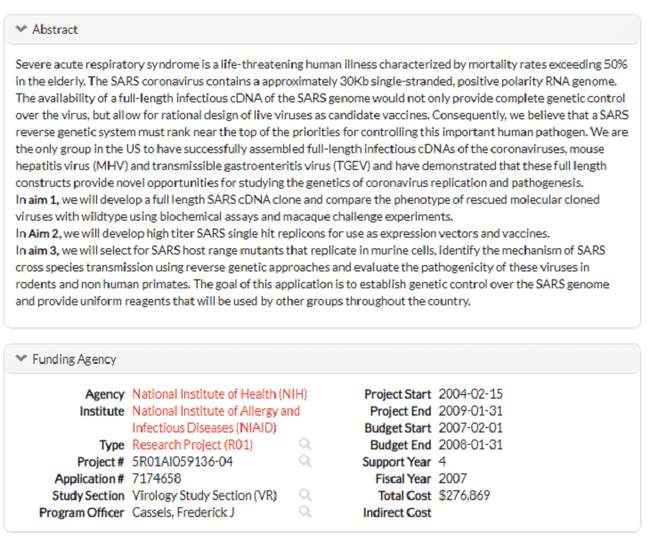
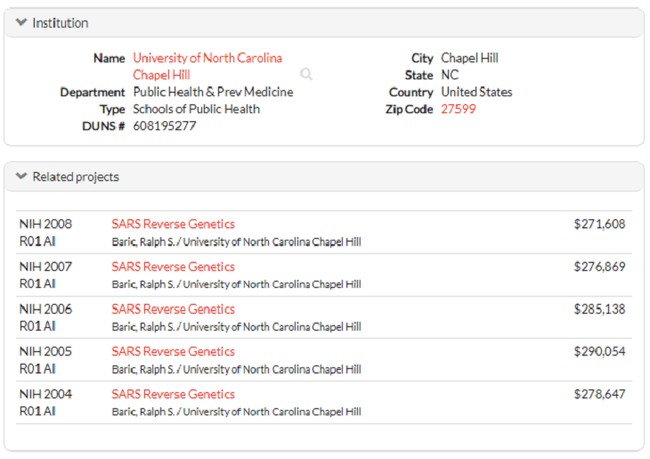
Over the course of five years, Baric was awarded more than $1.4 million to study the SARS virus. The goal of the research was to find ways to prevent new strains, but only produced a means of treating and preventing the original SARS virus. It was late in that study that Dr. Baric used the research to create what is called a recombinant virus or a mutation or new strain of certain viruses. These mutations can be natural but that also doesn’t mean that those viral mutations would have occurred naturally. Baric’s work was used as a means of additional study into SARS and was referenced by other doctors conducting NIH and NIAID funded research into the SARS virus:
“However, few zoonotic strains of SARS-CoV have been isolated and maintained in cell culture and this presents a challenge in assessing the efficacy of candidate SARS vaccines against zoonotic strains. Ralph Baric (UNC) has applied synthetic biology and reverse genetics techniques to generate recombinant isogenic viruses bearing variant spike glycoproteins derived from animal sources.”
If this could be considered the birth of gain-of-function studies of the SARS virus, Dr. Ralph Baric could be considered the “father” of it. It was hardly a “side project” of Dr. Baric’s research. It was the focal point. From 2007-2012, Dr. Baric received at least $18,500,000 in grants from the NIH and NIAID to study the SARS virus, including more than $5.6 million in the development of a SARS vaccine.
The MERS outbreak in 2012 renewed fears of the potential of a viral outbreak and ignited an urgency to double efforts on gain-of-function research. MERS, or the Middle East Respiratory Syndrome, is also a coronavirus and was found to have infected humans through bats and camels, with the latter likely providing a zoonotic link between the bat virus and human infection. According to the ECDC (European Centre for Disease Prevention and Control), MERS infected 2,586 people globally and was responsible for killing 939 of those people, primarily in Saudi Arabia. Again, Dr. Ron Fouchier of Erasmus University in Rotterdam, Netherlands was instrumental in sequencing and identifying the new viral strain. It seems no matter where you look in this story, the same five names keep coming up.
As a direct result of the MERS outbreak, Dr. Baric’s gain-of-function research was kicked into overdrive, with the awarding of a 10-million-dollar grant by the NIH. This new grant, which focused primarily on the SARS and MERS viruses, was awarded in September 2013, less than four months Dr. Fouchier identified the new strain of coronavirus responsible for the MERS outbreak. Baric’s lab at the University of North Carolina at Chapel Hill was quick to announce his newly landed funding.
From the release: (emphasis added)
“This new research promises to identify novel genes and genetic functions that promote virus pathogenesis in the host, leading to new targets for antiviral development and vaccine design,” Baric said. “Our group will focus on genes that contribute to highly pathogenic coronavirus infections, using SARS-CoV and MERS-CoV as a model.”
Other team leaders on the grant include Blossom Damania, Ph.D., professor of microbiology and immunology at UNC, whose research will focus on the human herpesviruses, and Yoshihiro Kawaoka, PhD, DVM, professor of virology at the University of Wisconsin, who will study Ebola and the highly pathogenic influenza virus gene that regulate disease severity following infection.”
As discussed yesterday, gain-of-function research done by Dr. Fouchier and Dr. Kawaoka led to concerns raised by scientists and government officials about the potential of accidentally creating or releasing a new, deadlier, and more transmissible strain of influenza. This discovery led to a pause in US government funding of gain-of-function research in 2014. NIH director (and co-author of the WaPo Op-Ed defending gain-of-function experiments), Dr. Francis Collins explained:
“During this pause, NIH will not provide new funding for any projects involving these experiments and encourages those currently conducting this type of work — whether federally funded or not — to voluntarily pause their research while the government determines how to proceed.”
On October 21, 2014, the United States Department of Health and Human Services sent a letter to UNC and Dr. Baric identifying gain-of-function research Baric was then performing under an NIH grant and requesting they pause that research until which time guidelines could be developed. Despite that request, Baric’s research continued.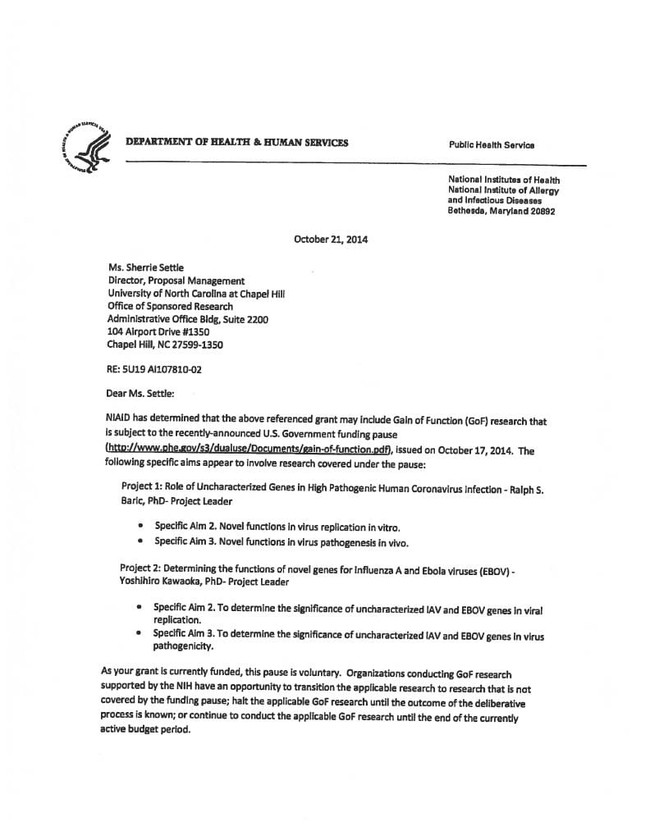
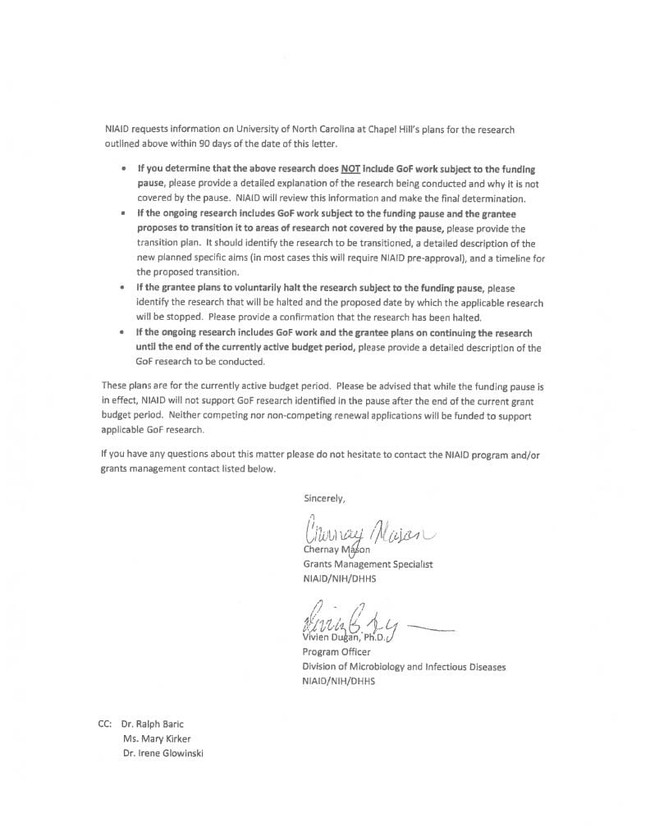
In November 2015, Baric addressed this (emphasis added):
“The latest study was already underway before the US moratorium began, and the US National Institutes of Health (NIH) allowed it to proceed while it was under review by the agency, says Ralph Baric, an infectious-disease researcher at the University of North Carolina at Chapel Hill, a co-author of the study. The NIH eventually concluded that the work was not so risky as to fall under the moratorium, he says.”
Here we have conflicting statements. The director of the NIH requested that all studies pause, the HHS requested the pause, the White House requested the pause, yet Baric is telling us the NIH told him he could continue his clearly gain-of-function research because it “was not so risky,” without producing any letter saying so. And, records show that NIAID continued funding Baric’s grant for three more years in violation of policy:
“In effect, the NIAID will not support GoF (gain-of-function) research identified in the pause after the end of the current budget period. Neither competing nor non-competing renewal applications will be funded to support applicable GoF research.”
What is happening here?
Baric wasn’t the only one ordered to cease that type of research; in fact, at least 14 other institutions received letters to pause research, including Dr. Yoshihiro Kawaoka at the University of Wisconsin, who complied with the request. In fact, Kawaoka did not resume his experiments on the H5N1 influenza virus until after the 2017 lifting of the gain-of-function ban and the release of gain-of-function guidelines by the HHS. Baric, however, presumably taking his direction from Dr. Fauci and the NIAID, continued his research.
During that pause, Dr. Baric (along with Dr. Shi Zhengli of WIV) was able to synthesize a new SARS virus, called SHC014, which took a viral strain of SARS that was previously unable to infect human cells and engineered it so that the viral strain was now able to infect humans, specifically “human airway cells” and which “resisted all vaccines and immunotherapy.” This again ignited a debate about the safety of this research and raised questions about how it was conducted against the recommendation of the HHS.
Clearly, it cannot be denied that, despite all of Dr. Fauci’s protestations to the contrary, NIH-funded gain-of-function research, which was conducted against the guidance of the White House and HHS, was shared with the Director at the Wuhan Institute of Virology. And if Dr. Fauci didn’t authorize those subsequent grant payments, who did?
Come back tomorrow for Part III, which will dive into the funding mechanisms which were used by the NIH to use US taxpayer dollars to fund research at the Wuhan Institute of Virology.

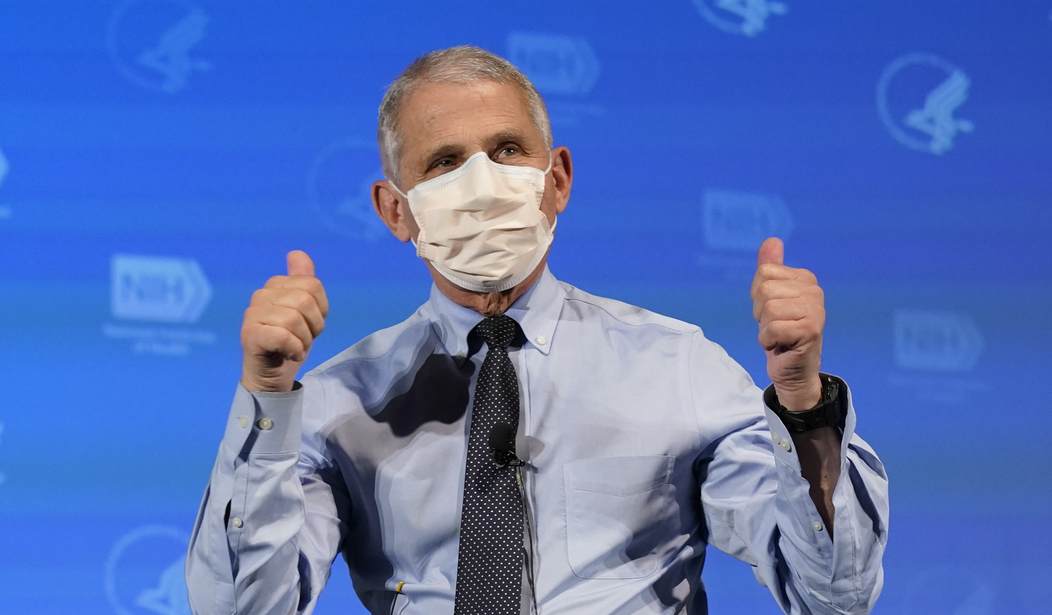









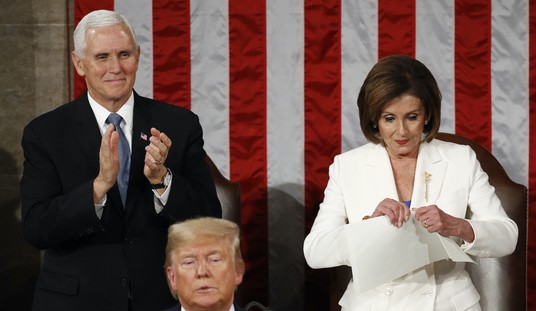


Join the conversation as a VIP Member